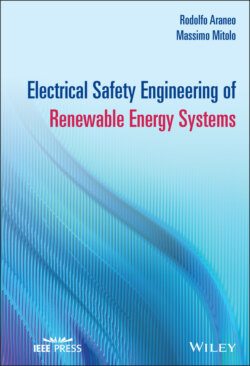Читать книгу Electrical Safety Engineering of Renewable Energy Systems - Rodolfo Araneo - Страница 26
1.10 Identification of Extraneous-Conductive-Parts
ОглавлениеWith the purpose of reducing touch voltages, applicable standards require that in each installation main protective bonding conductors connect to the main ground busbar the EXCPs, which may include: metal installation pipes for gas, water, heating, etc.; non-insulating floors and walls; exposed metallic structural parts of the building. These items are mere examples of conductive parts that may require the protective equipotential bonding; the identification of EXCPs is crucial for safety and a verification if conductive parts are EXCPs is necessary before connecting them to the ground busbar.
BS 76718 defines an EXCP as “a conductive part liable to introduce a potential, generally earth potential, and not forming part of the electrical installation.”
The term earth potential is generally assumed to be zero volts and introduced by the general mass of the earth into the installation. This definition implies that such conductive parts would originate outside the building and be in contact with the ground. If this can be verified by visual inspection, the part in question should be bonded as close as practicable to their point of entry within the building. It is important to clarify that for bonding purposes, the point of connection of pipework should take place along the section of the pipe from the meter into the building, which is owned by the user, and not on the section that comes in from the road into the meter. This prevents corrosion issues to the service pipework.
If it is not possible to verify by visual inspection alone that a conductive part is an EXCP, a measurement of the resistance REX between the conductive part in question and the main ground busbar should be performed. If the measured resistance REX satisfies Eq. 1.18, based on the circuit of Figure 1.16, the conductive part in question is not to be considered an EXCP.
(1.18)
Vth is the nominal voltage to ground of the installation (in V); RB is the standard value of body resistance of 1 kΩ; IBM (A) is the maximum value of body current that is deemed acceptable to the designer. Threshold values for IBM may be 0.5 mA (i.e., the threshold of perception), 10 mA (the threshold of let-go), or 30 mA.
However, the designer should assess if the measured resistance to the ground of the concerned conductive part may change (i.e., decrease) throughout the lifetime of the installation.
If, for example, the chosen threshold of safe current is 30 mA with vth = 230 V, and the measured resistance between a conductive part not forming part of the electrical installation (a presumed EXCP) and the ground is greater than 6.67 kΩ, then no connection to the main ground terminal of the metal part in question would be required.
It is important to recognize that the indiscriminate connection to the ground terminal of mere conductive parts that are not EXCPs may cause fault potentials to be transferred throughout the installation. This can cause the risk of electric shock for persons standing outside of the installation that is in contact with the presumed EXCP that has become live (e.g., a metallic fence).
